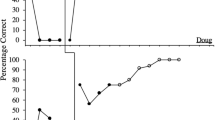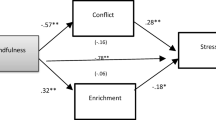Abstract
While there are several studies that have tested efficacy of implicit bias trainings, none have tested how working within a justice profession or how one’s racial identity impact outcomes following participation in such a training. Additionally, though empathy influences bias, no studies have tested for the effect of implicit bias training on ethnocultural empathy. The present study is a program evaluation of an implicit bias training program that examines the effects of profession and racial identity on outcomes, including ethnocultural empathy. The implicit bias training was a 3-h standardized training that described how implicit biases are formed, how they impact children in the school-to-prison pipeline and adults in society, the short- and long-term consequences of those biases, and strategies for responding to one’s own implicit biases. Participants who completed implicit bias trainings were 243 justice professionals and 274 non-justice professionals. Results indicated training outcomes were significantly associated with participant gender, race, racial identity, and whether participants worked in justice or non-justice professions. In addition, participants indicated several strengths and assets of the program; how receptive participants were to implicit bias training components was significantly associated with gender, race, and whether the participants worked in justice settings. The current study provides a necessary but incomplete picture of the strengths and weaknesses of this implicit bias training, lending support for continued trainings with more in-depth and longitudinal study of them.


Similar content being viewed by others
Notes
Removed items from pre- to post-training on the Scale of Ethnocultural Empathy measure: I feel annoyed when people do not speak standard English; I get impatient when communicating with people from other racial or ethnic backgrounds, regardless of how well they speak English; I feel irritated when people of different racial or ethnic backgrounds speak their language around me; When I know my friends are treated unfairly because of their racial or ethnic backgrounds, I speak up for them; When I see people who come from a different racial or ethnic background succeed in the public arena, I share their pride; When other people struggle with racial or ethnic oppression, I share their frustration; It is difficult for me to relate to stories in which people talk about racial or ethnic discrimination they experience in their day to day lives; I feel uncomfortable when I am around a significant number of people who are racially/ethnically different than me.
References
Albiero, P., & Matricardi, G. (2013). Empathy towards people of different race and ethnicity: Further empirical evidence for the Scale of Ethnocultural Empathy. International Journal of Intercultural Relations, 37(5), 648–655.
Alexander, M. (2020). The new Jim Crow: Mass incarceration in the age of colorblindness. New York: The New Press.
Avery, D. R., Tonidandel, S., Thomas, K. M., Johnson, C. D., & Mack, D. A. (2007). Assessing the multigroup ethnic identity measure for measurement equivalence across racial and ethnic groups. Educational and Psychological Measurement, 67(5), 877–888.
Bennett, M. W. (2016). The implicit racial bias in sentencing: The next frontier. Yale Law Journal Forum, 126, 391–405.
Colby, S. L., & Ortman, J. M. (2015). Projections of the size and composition of the US population: 2014 to 2060 (p. 9). Washington, DC: US Census Bureau.
Crenshaw, K. (1989). Demarginalizing the intersection of race and sex: A black feminist critique of antidiscrimination doctrine, feminist theory and antiracist politics (p. 139). Chicago: University of Chicago Legal Forum.
Crenshaw, K. W. (1993). Beyond racism and misogyny Black feminism and 2 Live Crew. Words that wound (pp. 111–132). Abingdon: Routledge.
Dawson-Edwards, C., Tewksbury, R., & Nelson, N. T. (2017). The causes and pervasiveness of DMC: Stakeholder perceptions of disproportionate minority contact in the juvenile justice system. Race and Justice, 10, 223–242.
Devine, P. G. (1989). Stereotypes and prejudice: Their automatic and controlled components. Journal of Personality and Social Psychology, 56(1), 5.
Devine, P. G., Forscher, P. S., Austin, A. J., & Cox, W. T. (2012). Long-term reduction in implicit race bias: A prejudice habit-breaking intervention. Journal of Experimental Social Psychology, 48(6), 1267–1278.
Eisenberg, N., & Strayer, J. (1990). Empathy and Its Development: CUP Archive. Cambridge: Cambridge University Press.
Fiske, S. T. (1998). Stereotyping, prejudice, and discrimination. The Handbook of Social Psychology, 2(4), 357–411.
Hanley, A., Garland, E., Canto, A., Warner, A., Hanley, R., Dehili, V., et al. (2015). Dispositional mindfulness and bias in self-theories. Mindfulness, 6(2), 202–207.
Helms, J. E. (1990). Black and white racial identity: Theory, research, and practice. Westport: Greenwood Press.
Helms, J. E. (1997). Toward a model of white racial identity development. College student development and academic life: Psychological, intellectual, social and moral issues (pp. 49–66). New Yor: Routledge.
Hockenberry, S., & Puzzanchera, C. (2018). Juvenile court statistics 2015. Pittsburgh: National Center for Juvenile Justice.
Holladay, C. L., & Quiñones, M. A. (2008). The influence of training focus and trainer characteristics on diversity training effectiveness. Academy of Management Learning & Education, 7(3), 343–354.
Jackson, S. M., Hillard, A. L., & Schneider, T. R. (2014). Using implicit bias training to improve attitudes toward women in STEM. Social Psychology of Education, 17(3), 419–438.
Juvenile Justice and Delinquency Prevention (JJDP) Act, 42 U.S.Code C.F.R. (1974).
Kang, J., Bennett, M., Carbado, D., & Casey, P. (2011). Implicit bias in the courtroom. UCLA Law Review, 59, 1124–1186.
Leiber, M., & Fix, R. L. (2019). Reflections on the impact of race/ethnicity on juvenile court outcomes and efforts to enact change. American Journal of Criminal Justice, 44, 581–608.
Lowry, R. (2001). Log-linear analysis for an AxBxC contingency table. Retrieved from December 9, 2019. https://vassarstats.net/abc.html.
McKeachie, W., & Svinicki, M. (2013). McKeachie's teaching tips. Boston: Cengage Learning.
Moss-Racusin, C. A., Pietri, E. S., Hennes, E. P., Dovidio, J. F., Brescoll, V. L., Roussos, G., et al. (2018). Reducing STEM gender bias with VIDS (video interventions for diversity in STEM). Journal of Experimental Psychology: Applied, 24(2), 236–260.
Nosek, B. A., Banaji, M. R., & Greenwald, A. G. (2002). Harvesting implicit group attitudes and beliefs from a demonstration web site. Group Dynamics: Theory, Research, and Practice, 6(1), 101.
Okonofua, J. A., Paunesku, D., & Walton, G. M. (2016). Brief intervention to encourage empathic discipline cuts suspension rates in half among adolescents. Proceedings of the National Academy of Sciences, 113(19), 5221–5226.
Paluck, E. L., & Green, D. P. (2009). Prejudice reduction: What works? A review and assessment of research and practice. Annual Review of Psychology, 60, 339–367.
Perez, L. M., Miller, M. K., Summers, A., & Marsh, S. C. (2017). Assessing interventions to reduce judicial bias. Enhancing justice, reducing bias. Chicago: American Bar Association.
Phinney, J. S. (1992). The multigroup ethnic identity measure: A new scale for use with diverse groups. Journal of Adolescent Research, 7(2), 156–176.
Phinney, J. S., & Alipuria, L. L. (1996). At the interface of cultures: Multiethnic/multiracial high school and college students. The Journal of Social Psychology, 136(2), 139–158.
Phinney, J. S., & Ong, A. D. (2007). Conceptualization and measurement of ethnic identity: Current status and future directions. Journal of Counseling Psychology, 54(3), 271.
Rachlinski, J. J., Johnson, S. L., Wistrich, A. J., & Guthrie, C. (2008). Does unconscious racial bias affect trial judges. Notre Dame Law Review, 84, 1195–1246.
Rudman, L. A., Ashmore, R. D., & Gary, M. L. (2001). " Unlearning" automatic biases: The malleability of implicit prejudice and stereotypes. Journal of Personality and Social Psychology, 81(5), 856–868.
Sellers, R. M., Smith, M. A., Shelton, J. N., Rowley, S. A., & Chavous, T. M. (1998). Multidimensional model of racial identity: A reconceptualization of African American racial identity. Personality and Social Psychology Review, 2(1), 18–39.
Shook, J. J., & Sarri, R. C. (2007). Structured decision making in juvenile justice: Judges' and probation officers' perceptions and use. Children and Youth Services Review, 29(10), 1335–1351.
Sickmund, M., Sladky, T. J., & Kang, W. (2018). Easy access to Juvenile court statistics: 1985–2015. Washington DC: Office of Juvenile Justice and Delinquency Prevention.
Spinney, E., Cohen, M., Feyerherm, W., Stephenson, R., Yeide, M., & Shreve, T. (2018). Disproportionate minority contact in the U S juvenile justice system: A review of the DMC literature, 2001–2014 Part I. Journal of Crime and Justice. https://doi.org/10.1080/0735648X.2018.1516155.
Sue, D. W., Torino, G. C., Capodilupo, C. M., Rivera, D. P., & Lin, A. I. (2009). How White faculty perceive and react to difficult dialogues on race: Implications for education and training. The Counseling Psychologist, 37(8), 1090–1115.
Sue, D. W., Rivera, D. P., Capodilupo, C. M., Lin, A. I., & Torino, G. C. (2010). Racial dialogues and White trainee fears: Implications for education and training. Cultural Diversity and Ethnic Minority Psychology, 16(2), 206.
Sukhera, J., & Watling, C. (2018). A framework for integrating implicit bias recognition into health professions education. Academic Medicine, 93(1), 35–40.
The Sentencing Project. (2017). Black Disparities in Youth Incarceration. Washington DC: The Sentencing Project. Retrieved from December 9, 2019. https://www.sentencingproject.org/publications/black-disparities-youth-incarceration/.
Tincher, , L. W. (2016). Mindful attention reduces linguistic intergroup bias. Mindfulness, 7(2), 349–360.
Wang, Y.-W., Davidson, M. M., Yakushko, O. F., Savoy, H. B., Tan, J. A., & Bleier, J. K. (2003). The Scale of Ethnocultural Empathy: Development, validation, and reliability. Journal of Counseling Psychology, 50(2), 221.
Wistrich, A. J., Rachlinski, J. J., & Guthrie, C. (2014). Heart versus head: Do judges follow the law of follow their feelings. Texas Law Review, 93, 855–923.
Acknowledgement
Edward Palmer, Sr. developed and conducted the implicit bias trainings, and was responsible for data collection.
Funding
This is not a funded or grant-supported study.
Author information
Authors and Affiliations
Corresponding author
Ethics declarations
Conflict of interest
Rebecca L. Fix declares that she has no conflict of interest regarding the present study or manuscript.
Ethical Approval
All procedures performed in studies involving human participants were in accordance with the ethical standards of the institutional and/or national research committee and with the 1964 Helsinki declaration and its later amendments or comparable ethical standards.
Informed Consent
Informed consent was obtained from all individual participants included in the study.
Additional information
Publisher's Note
Springer Nature remains neutral with regard to jurisdictional claims in published maps and institutional affiliations.
Rights and permissions
About this article
Cite this article
Fix, R.L. Justice Is Not Blind: A Preliminary Evaluation of an Implicit Bias Training for Justice Professionals. Race Soc Probl 12, 362–374 (2020). https://doi.org/10.1007/s12552-020-09297-x
Published:
Issue Date:
DOI: https://doi.org/10.1007/s12552-020-09297-x




